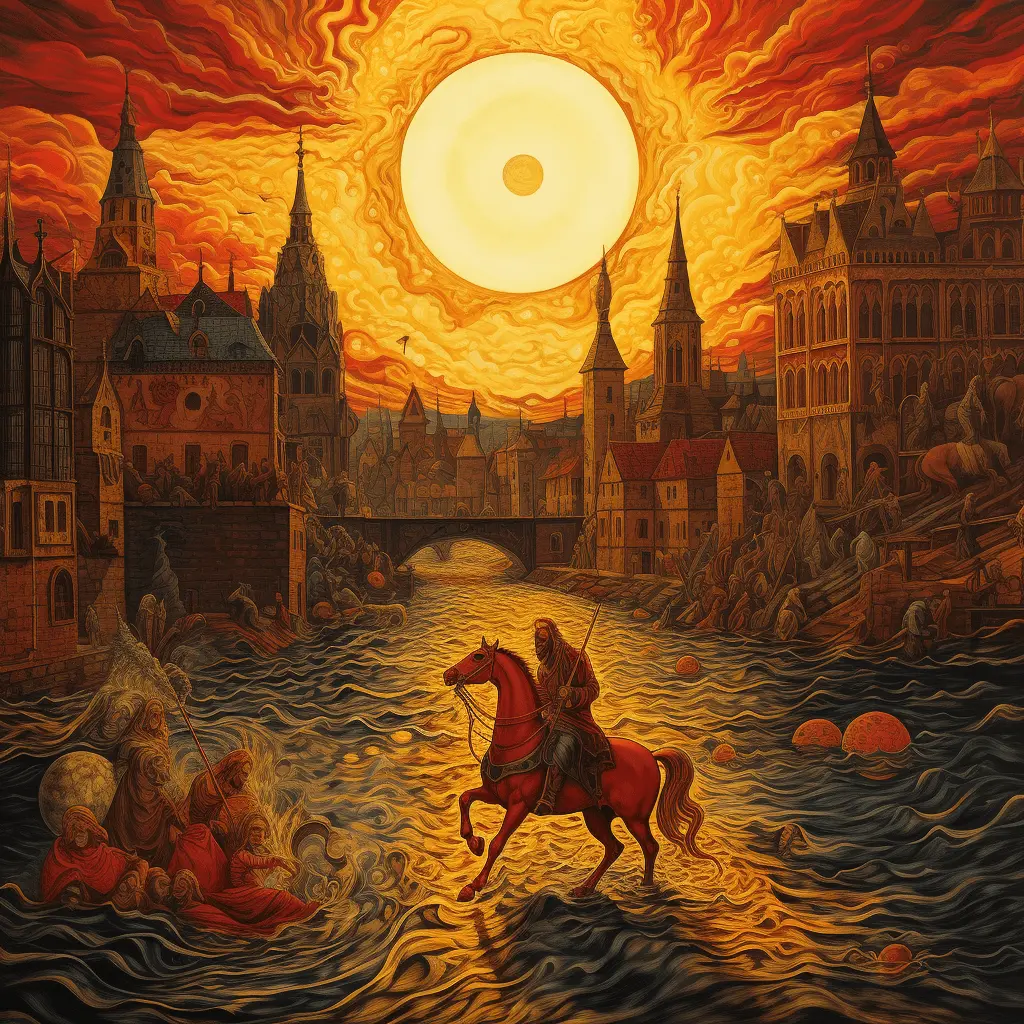The Swiss Book of Legends
According to oral traditions, chronicles and other printed and handwritten sources and is accompanied by explanatory notes.
Leipzig 1854
Wodan’s Revenge
When the pagan deities succumbed to the Christianity and also the inhabitants of Vaud swore to the its new doctrine, the resentment of the defeated gods against their former followers was so great that they sought to harm them as much as possible in their temporal good by the elements over which they had not yet completely lost power at that time, in order to punish them for their apostasy and to make their faith in the new god waver. First of all it was Wodan, the first of the pagan gods, who took such revenge. Sometimes he roared as an unleashed storm, sometimes on the cloud of thunder, destroying the fields and crops of rich and poor.
Thus he once came down the Rhône in the old splendor on a high-built wave, like sitting on a war horse, holding a battle sword in one hand and the globe in the other. Then he shouted, “River, Rise!” and the Rhône rose at his command, flooded the bank and, devastating the whole area, swept away part of St. Maurice. The only place unharmed by the flood was the place where the altar to the new God was erected. Only then did Wodan realize his powerlessness against the Christian God.
Never again since that time has Wodan shown himself to mankind, never again has he dared to try again to found his kingdom among them. Only at night, at certain times of the year, he still lets himself be heard in the roar of the storm, high up on the glaciers, between rocks and stones, in the gloomy forest floor, but more to torment himself than to the harm of mankind. Unseen by human eyes, he then walks along them in a hideous procession, Freya, his wife, once a kind goddess, now an evil sorceress, at his side, and what is eternally damned follows him: Suicides, drunkards, unbaptized dead children, beheaded and hanged malefactors, voluptuous women1, witches and sorcerers, bloodthirsty mermaids and mischievous gnomes, in short, the host of all those evil spirits whose realm is the rocks and glaciers of the Alps. It is said that heir number is so great that, if they were to divide amongst themselves those rocks and glaciers, hardly a pound of the mighty mass of ice and rock would be given to each one.
Thus sank Wodan, once worshipped by the people as a holy god.
As noted by: C. Kohlrusch
Legends of nocturnal processions of ghosts, which at certain times of the year can be heard in the air with a terrible noise, are at home not only in Switzerland, but in all parts of the sky. But wherever one meets them, they owe their first appearance to the sonorous vibrations of the air, which are wont to precede great changes in temperature; That is why it is also said in the legend of the WuütiSsheere that is at its most mad at Christmas time, at which time violent nightly storms usually announce the beginning of winter. As far as the legend of the raging army or Wütisheere, as it is called in the Bernese Oberland, is concerned, it is very old and is closely connected to the highest deity of our pagan ancestors, Wodan, as is his name, furious army, southern German: Muotes Heer, originally meant nothing else than the Wuotane army. Our ancestors thought of the all-father Odin, Othan, Wuotan or Wodan among other expressions of his all-pervading power as the guide of the battles and as the guide of the heroes who fell in battle in their heavenly hunting pleasures in Valhalla, which they carried over their heads to the sound of the air heard. At Scchonen, a peculiar noise, probably originating from seabirds, which can be heard on the evenings of December, is still called Odens Jagd. However, the sensuous myth in which paganism had clothed the natural phenomenon of the howling storm wind was later obscured by the victorious Christianity, in that here, as everywhere else where the remains of the old faith could not be completely supplanted, the same were replaced by ugly, distorting additions or tried to bring changes into another terrifying version. Thus it transformed the almighty sky-god Odin or Wodan into the devil, and the spirits of the happily departed heroes led by him into the souls of the eternally damned, who, as a raging host, that deity in her new form at the spear, superstitious minds at that moment> fill noFg with fear and screams. But the fact that the devil in the above saga relinquishes his office as leader of the raging army to the gigantic Uroin inhabitants of the country (the idea that giants are his leaders is the more general one in Switzerland) lies in the close connection which, according to the Christian mythical point of view between the idea of the devil and that of the giants, a point to which we shall return later.
An interesting compilation of sonorous aerial phenomena, which called into existence myths analogous to the raging army, is brought by F. Nork after a collection of testimonies from credible travelers about the so-called “voices from above” published by the university chancellor Autenrieth in Tübingen. Thus the Englishman Davy relates that in Ceylon in April, at the beginning of the rainy season there, he heard the “demon bird” of the natives in the flat, wooded part of the island, which no one had yet seen from, therefore he applies to the inhabitants as a messenger of death.
The Dutchman Hafner heard, also on Ceylon, when he wandered through the mountainous highlands of the island at the end of the rainy season, at midnight a distant dog barking, which seemed to come out of the opposite mountains. This sound soon became louder and louder, soon he thought he heard laughing, soon swearing human voices. All these sounds came and went in some minutes alternately again in the nearness and in the distance, soon they seemed to him from the height to float down, soon deeply from the (earth up to whimper. Then, suddenly, there was a deathly silence, and just as suddenly, voices resounded through the air again, answered by the echo of the neighboring mountains. Then, close behind the cliff under which he was looking for shelter, such a shrill scream sounded in his ears as if his drumhead should burst. Out of his mind he rushed out from under his rocky obdacch. It was as if a hundred screeching sounds, so false, so strange, so unheard, rang in his ears that he hurriedly jumped back into the cave. Later, in Jaffanapatnam, he heard that similar voices were not uncommon in the mountains and on the banks of the Mawelingangastrom and, according to local folk belief, were produced by spirits banished there. A man from Medlenburg named Wolf, who spent twenty years in Ceylon and published his travelogue in 1784, as well as the Englishman Knox, who published a work about this island in 1681, also claim to have heard these terrible voices. The former says of it: it runs so gescchhhwind from one place to another that neither the wind, nor a bird could have such speed. In a few seconds you can hear it almost a quarter of an hour away. Similarly, the rarer traveler expresses himself, only he adds: the whole world there believes that the devil is the one who emits this gruesome scream at night. Sounds like the noise of weapons or of various musical instruments have been noted by several travelers in the Kobi desert, which separates the snowy, mountainous Tibet from the mild regions of Asia, and Morier, who traveled through Persia at the beginning of this century, remembers a high-altitude salt desert near the city of Khom, where travelers would be lost and torn apart by the scream of a ghost, called ghoul by the inhabitants. Russian news about Kiev tell of an island in a salty marsh between the Caspian Sea and the Aralsce, which is avoided by travelers as the abode of evil spirits because of the barking of dogs and various other animal voices that can be heard there at night. In western Asia, these sounding air phenomena or voices from the heights are no less well known. Among the rabbis the Bath Kol (the voice from on high) takes the place of the earlier direct revelation, and to such Paul attributed his conversion. Finally, the monks of the monastery located on Mount Sinai knew to tell the traveler Burkhardt, who climbed it in 1816, much about a thunderous noise, which could be heard several times from its summit. It is possible that in Mosaic times this sound was considered the language of God revealing himself to his people. Similar thunderous sounds were heard by Father Gilii in 1782 on the banks of the Orinoco in South America, and the Dutch on the southern tip of Africa, on the promontory of the Good Hope, called a mountain the Devil’s Mountain, because of the roar that is heard there.
As we see, all these strange natural phenomena are in their basic features the same, only that the sounds heard here and there, depending on the nature of the land, produce a more or less gruesome effect, from which the imagination was usually also guided in the creation of their mythical ideas. Legends of Wütisheer are still linked in the canton of Bern to various places, such as the Büttenberg and the Hühnliwald, on the left side of the road to Thun, where, according to antiquarian data, a sacrificial site is said to have been in both times. Analogous to the Wütisheere are the next two legends, which, since they find almost the same explanation based on natural phenomena, may follow here without further explanation.
-
I wonder if this translation is wrong. ↩



